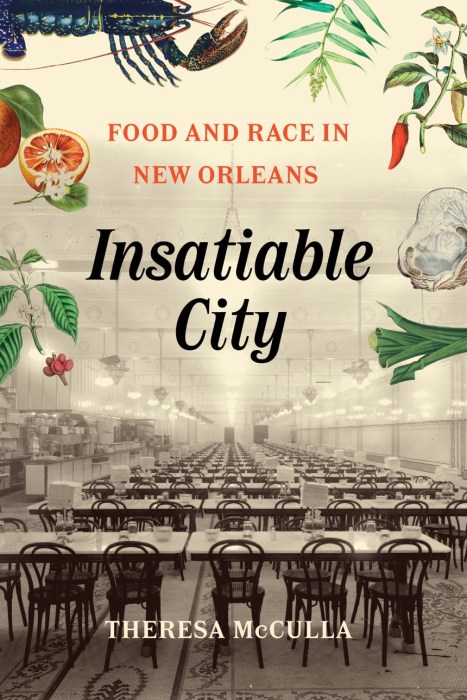“The Insatiable City: Food and Race in New Orleans” by Theresa McCulla
c.2024,
The University of Chicago Press
$32.50
345 pages
You’ve spent a lot of time scouring the internet in search of menus.
Will you try this dish, or that one? Sample two entrees, or three? Can you understand the people in a city without tasting their best dishes? You’ll know soon enough because you’ve chosen the restaurants for your dining experiment but remember: as in the new book “Insatiable City” by Theresa McCulla, the taste of the truth may be bitter.
In the early summer of 1719, the slave ship the Aurora, “the first ship bearing enslaved people to arrive in Louisiana from Africa” dropped anchor just off the French territory of Basse-Louisiana, near the city of New Orleans. Once the ship was emptied, her human cargo was fed and then immediately taken and sold on a large auction block at a market inside a “luxurious hotel” while white buyers ate and drank their fill at a nearby bar.
This one act forever tied New Orlean’s famous cuisine with its racial history

McCalla says that enslaved women who were known to be “good cooks” were in high demand by white owners who dreamed of the meals to come. What those men probably never thought about was that, because slaves were forbidden to read or write, recipes for those meals were shared verbally, having sprang from a variety of cultures and lands. The ingredients for those meals were planted by Black hands, harvested by Black hands, prepared by Black cooks, served by Black slaves, and the table was cleared by Black servants.
In later years, when the French Market was first opened, Black marchandes sold their wares – cheese, coffee, fruits and vegetables – both at the market and to white homes that lined the streets – and gained a little upward mobility. Black cooks found their way out of white homes, and onto ships that docked nearby, and into the city’s opulent hotel kitchens.
Ultimately, restauranteers were forced to acknowledge Black and Creole contributions to their menus – but not without a lot of fight, and a lot of Jim Crow, too.
Despite that its subject is such a fascinating one, “Insatiable City” could be a bit of a struggle to read. The topic is narrow – how African Americans left a hidden-in-plain-sight thumbprint on the many famous dishes of New Orleans and, indeed, Louisiana – and so there’s a lot of the same inside the narrative here.
Dig in, though, just a little deeper.
Fortunately, author Theresa McCulla includes a wealth of stories that save this book – stories that came from former slaves, courtesy of the WPA; advertisements, photographs, and menus; and accounts from Black and white journalists and eyewitnesses traveling in the city. Through these old documents, readers will not only learn about the many dishes of New Orleans, but also about individual people and cooks, and the politics of food in decades past.
This book will appeal to anyone who reads cookbooks for fun, and for anyone planning a trip to the Crescent City any time soon. Find “Insatiable City.” It should be what’s on your reading menu.























